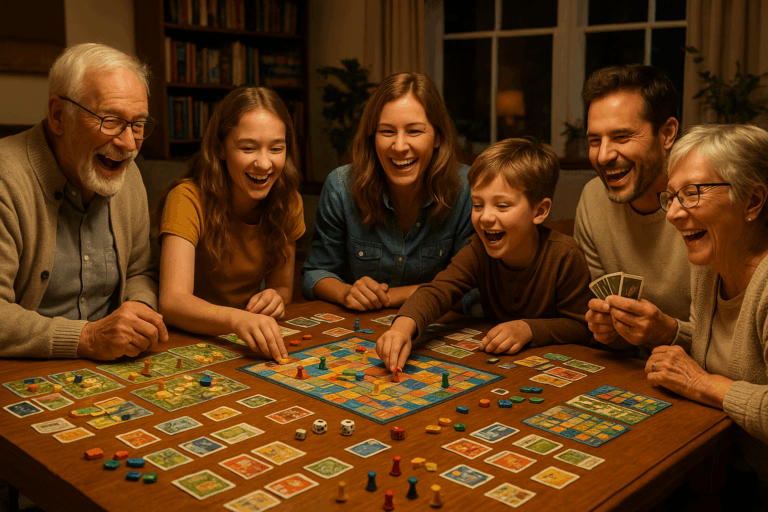Even the most diligent parents may struggle to pull their children away from the captivating glow of tablets, smartphones, and consoles. Yet, in the heart of this digital age, a classic entertainment medium is making a surprising comeback: board games. 🎲
But, these aren’t the board games of yesteryears. They are interactive, stimulating, and innovative educational tools that encourage children to explore, create, and learn while having fun. These contemporary board games, many of which are designed with input from educators and child psychologists, are more than just a pastime; they are a gateway to boundless creativity and learning.
Rediscovering the Magic of Board Games
Board games, a cornerstone of family bonding and social interaction, have been around for millennia, but their potential to be an exciting learning tool is often overlooked. Today’s new breed of board games, however, is designed with a unique blend of fun and learning in mind. They present kids with fun challenges that require critical thinking, problem-solving, and teamwork, all while stimulating their imagination and creativity. 🧠✨
From simple games that help toddlers recognize shapes and colors, to intricate board games that teach older kids about strategy, science, history, and much more, these games can ignite a child’s passion for learning. So, let’s embark on an adventure to rediscover the magic of board games and their role in sparking creativity and learning.
Unveiling the Educational Power of Board Games
Perhaps, you’re skeptical. Could a simple board game genuinely make a difference in a child’s cognitive development? Well, the short answer is, absolutely yes! The trick lies in the game mechanics, the way the game encourages interaction, and the subject matter. Board games can help kids develop essential skills, such as critical thinking, spatial awareness, communication, negotiation, and patience, among many others. 🎯
Furthermore, the hands-on and interactive nature of board games provide a form of experiential learning that can be far more effective than traditional teaching methods. Instead of memorizing facts from a textbook, kids get to actively participate in the learning process. And, as we all know, we learn best when we’re having fun.
The Journey Ahead: A Guide to Kid-Friendly Board Games that Spark Creativity and Learning
In this article, we’ll delve deeper into the world of modern board games designed for children. We’ll discuss their benefits, how they promote learning, and, of course, some of the best board games out there that cater to different age groups. So, buckle up and join us on this exciting journey of discovery and learning. Whether you’re a parent, an educator, or just someone interested in the unique intersection of education and entertainment, there’s something for everyone in the following sections. 🚀
We promise you a riveting exploration into the captivating world of board games that not only provide fun for the whole family but also help spark creativity and facilitate learning in children. Whether you’re looking for a game to entertain your kids on a rainy day or a tool to supplement their education, we’ve got you covered. Let’s turn the tables on the digital age, one board game at a time. 🌈📚
Unleashing the Magic: Board Games that Ignite Creativity and Learning
As a parent, finding the perfect balance between entertainment and education can be a daunting task. However, kid-friendly board games are a fantastic tool to strike that balance. They not only provide a fun family activity but also serve as an excellent means to stimulate creativity and learning in children. If you’re intrigued and want to discover more about this beneficial blend of fun and learning, let’s dive into this immersive world of board games together.
Board games have come a long way from the traditional Monopoly and Scrabble. Today, they can offer a variety of benefits such as enhancing problem-solving abilities, developing social skills, improving memory, and above all, sparking creativity. But with the market flooded with countless options, how do you pick the right one? To aid your selection, we’ve compiled a list of some of the best kid-friendly board games that foster creativity and learning.
In this article, we will look at how these games work, what skills they help to develop, and how to choose the right game for your child’s age and interests. You will also find a handy comparative table and a link to an informative YouTube video for a more comprehensive understanding.
Decoding the Benefits: How Board Games Stimulate Creativity and Learning
Board games are an ingenious way of sneakily incorporating educational elements into an enjoyable setting. While your children are having a great time playing, they are also developing key skills and learning valuable lessons.
The first significant benefit of board games is the development of cognitive skills. These games often require players to think strategically, predict outcomes, and make decisions, all of which help enhance problem-solving abilities. Board games can also boost memory and concentration, as they typically require players to remember specific rules, strategies, or the location of game pieces.
On a more personal level, board games also promote social skills. Playing these games necessitates communication and interaction with other players, encouraging children to learn how to share, wait their turn, and respect others. These skills are vital for social development and can greatly aid in their interactions outside the gaming world.
🔍Explore Further: “The Benefits of Board Games for Kids” by TED-Ed on YouTube
If you want to delve deeper into the advantages of board games for children’s development, consider watching this insightful video by TED-Ed titled “The Benefits of Board Games for Kids”. It provides a scientific perspective on how board games can influence cognitive and social development in children.
Top Picks: Kid-Friendly Board Games that Promote Creativity and Learning
Now that we understand the benefits of board games for children’s development, let’s take a look at some of the best games on the market that foster creativity and learning.
The first game on our list is “Ticket to Ride: First Journey”. This game is a simplified version of the original “Ticket to Ride” designed specifically for younger children. It is an excellent tool to teach geography and strategic planning.
Next up is “Catan: Junior”. This game is a kid-friendly version of the classic game “Catan”. It encourages strategic thinking, resource management, and negotiation skills.
Game
Age Group
Key Learning Outcomes
Ticket to Ride: First Journey
6+
Geography, Strategic planning
Catan: Junior
6+
Strategic thinking, Resource management, Negotiation skills
For a more detailed look at these games and other top picks, consider watching the following YouTube video titled “Top 10 Educational Board Games for Kids” by WatchMojo.com.
🎥Watch Now: “Top 10 Educational Board Games for Kids” by WatchMojo.com
In this video, you will find a more comprehensive overview of our top picks and other highly recommended educational board games for kids. Get a sneak peek into the gameplay and see which one suits your child’s interests the best.
Choosing the Right Game: Factors to Consider
With the vast variety of board games available in the market, choosing the right one for your child can be a challenge. However, considering a few key factors can greatly simplify this task.
Firstly, consider the age recommendation of the game. This is crucial to ensure that the game is appropriate for your child’s developmental stage and that they can understand and enjoy it. Secondly, consider your child’s interests. If they love fantasy, a game like “Dragonwood” would be more appealing than a game based on historical events. Finally, consider the educational value of the game. While having fun is important, choosing a game that also promotes learning and skill development is a smart choice.
Remember, the ultimate goal is to foster a love of learning and creativity in your child while having fun. So, don’t stress too much about finding the ‘perfect’ game. Instead, focus on finding a game that your child will enjoy and learn from.
ConclusionIn conclusion, this discourse has engaged on a comprehensive journey, tracing the convolutions of the intricate world of Information Technology and Engineering. We have navigated through the most prominent points, the crux of the subject matter. The central focus has been on the way technical writing has revolutionized the manner in which complex concepts are comprehended. In addition, we have delved into how a background in Software Engineering acts as a potent weapon in tackling complex technical writing tasks.
Reflecting on the key aspects, we examined how technical writing, particularly in areas like IT and engineering, has the capability to morph elaborate, challenging ideas into understandable, accessible language. This transition, in turn, makes it easier for a wider range of people to comprehend, engage with, and even further develop the technologies and solutions being discussed.
Drawing from my expertise and decade-long experience as a technical writer, we delved into the importance of well-structured, detailed, and technically accurate articles. The rationale being, these are not merely tools for conveying information, but are instrumental in shaping perceptions, influencing decisions, and, ultimately, driving innovation.
Having established the importance of the topic, it is imperative to not lose sight of the broader perspective. Technology is a tool, and it’s only as potent as its wielder. Thus, let’s not just aim to understand the tools, but also strive to be adept at using them. In this age of information, being able to efficiently communicate technical information is more than a skill; it is a necessity.
I urge you to not just be a consumer of this information, but be a participant. Take these insights, and apply them to your professional life. Share them with your peers, and encourage a dialogue about the importance of effective technical communication. Let’s strive to push the envelope and elevate the standard of technical writing within our respective fields.
Remember, the doors of learning swing both ways. Therefore, I invite you to comment with your thoughts, experiences, and ideas on this topic. Let’s engage in a fruitful exchange of insights that will contribute to our collective growth and understanding. To delve deeper into the subject, feel free to visit this source.
To conclude, as Stephen King aptly said, “Writing isn’t about making money, getting famous, getting dates, getting laid, or making friends. In the end, it’s about enriching the lives of those who will read your work, and enriching your own life, as well.” Therefore, let’s commit ourselves to the noble task of effective technical writing, one step at a time. 🖋️📚🚀
Tags: #TechnicalWriting #SoftwareEngineering #IT #Innovation #Communication
References:
1. Grammarly
2. TechWhirl



